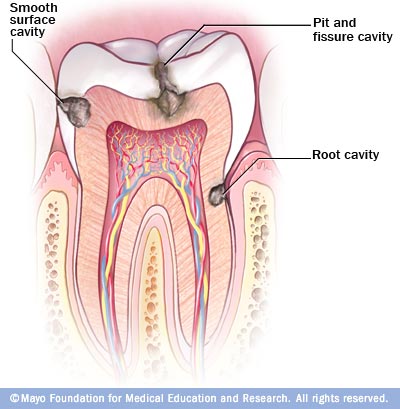
So, what is a Cavity? Cavities are what they sound like; they are holes that occur in your teeth. They typically occur because of tooth decay that wears away at the tooth structure. The tooth has two protecting layers from the pulp. The first is the enamel (the outer protective wall), and the second is the dentin (the inner protective wall). When a hole is created in your outer level, you have a cavity.
The easiest way to discover a cavity is to probe it with a dental instrument. It will often catch on the surface and is very recognizable to someone with experience and training. X-rays can also show cavities in your teeth and are often the preferred method of finding cavities in between teeth.
When a cavity goes past the enamel and the dentin, your tooth has a hole that reaches the dental pulp. The pulp may be very sensitive to hot and cold, and runs a risk of infection. If your dentist discovers the cavity before the pulp gets infected (often even before it reaches the pulp), he/she may do a filling. They will drill away the damaged portion of the tooth and replace it with a dental material.
If the damage to the tooth is more than a single cavity but a serious of cavities and involves extensive decay of the tooth, you may need a crown. This is where your dentist essentially drills away the decaying parts of the tooth, builds it back up, and then covers it with a crown. This is a common route to take also if the tooth has been fractured by trauma as opposed to dental cavities.
If the tooth becomes infected, it will cause lingering pain and may be incredibly sensitive. Once infected, they will need to perform a root canal to the dead pulp, and seal the apex of the tooth. The rest of the tooth will be built-up and covered by a crown to protect it from fracturing. Endodontically (root canal) treated teeth lose their innervation and blood supply and over time may become brittle and fracture. A crown will cover the tooth and prevent this from happening.